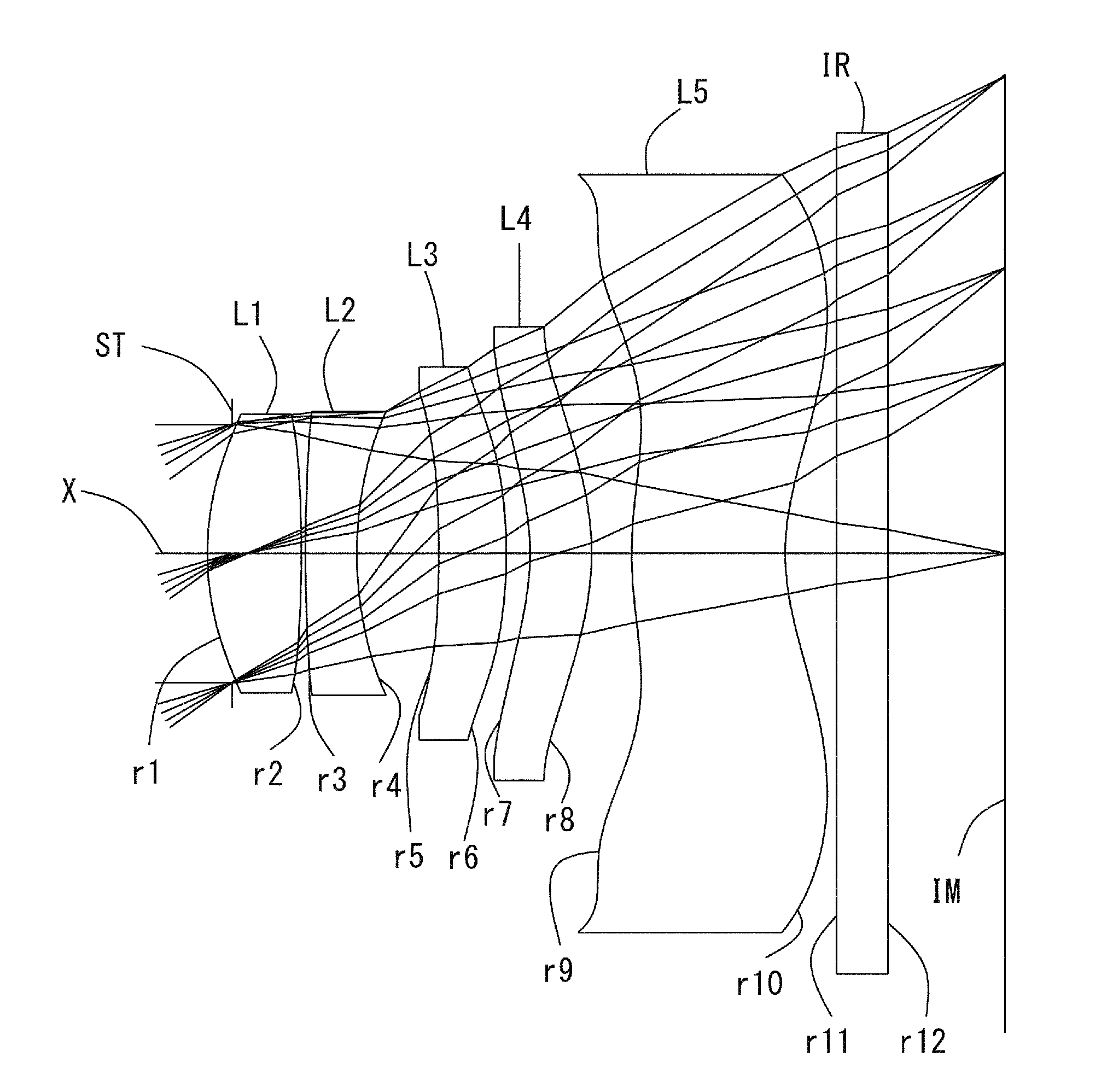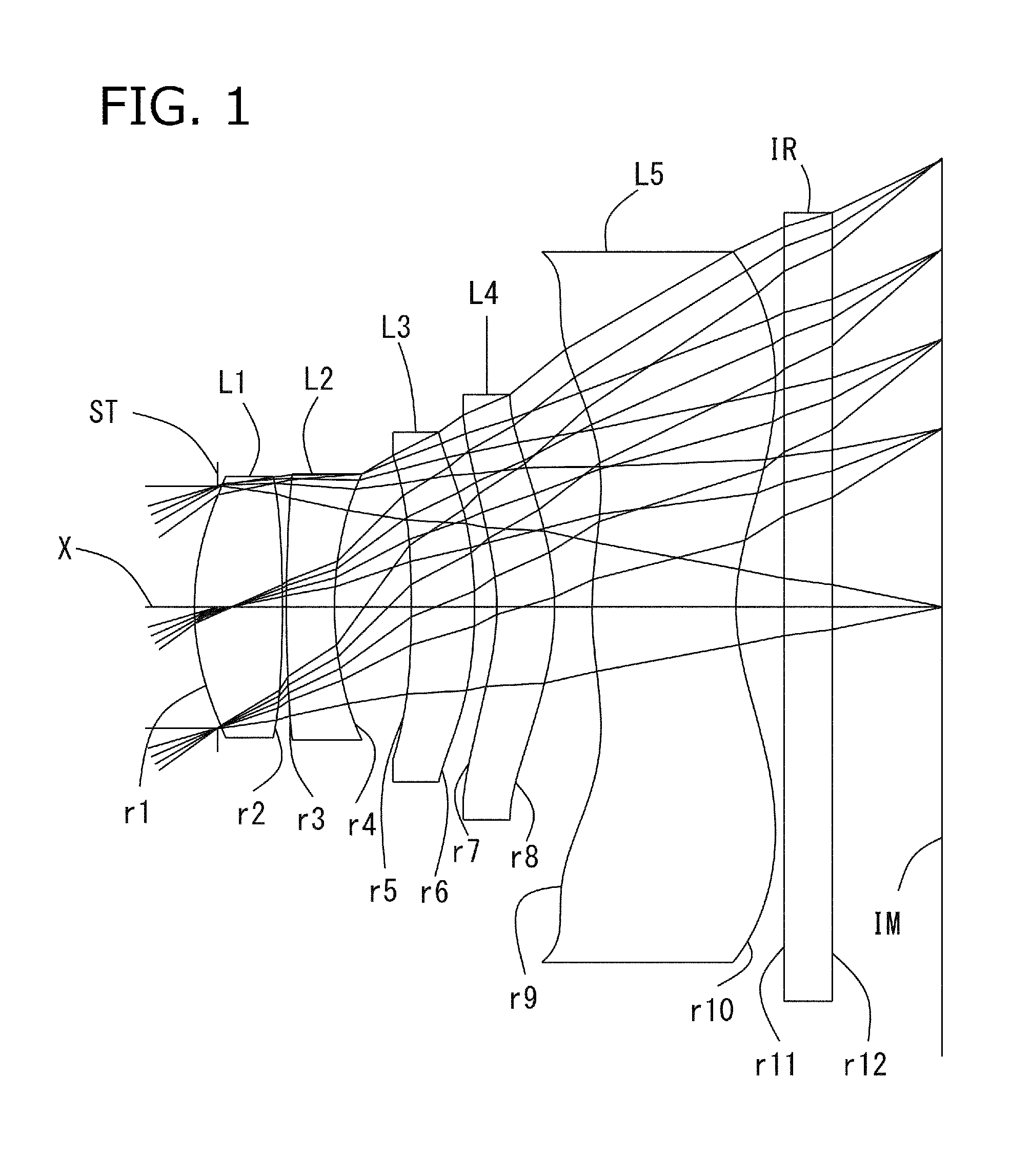Image pickup lens
a pickup lens and image technology, applied in the field of image pickup lenses, can solve the problems of not being able to say, the lens provides a sufficiently bright lens system or a wide angle, and the image pickup lens is described, and achieves the effects of small f-value, reduced size and thinning, and high resolution
- Summary
- Abstract
- Description
- Claims
- Application Information
AI Technical Summary
Benefits of technology
Problems solved by technology
Method used
Image
Examples
embodiment 1
[0057]Basic lens data are shown in Table 1 below.
TABLE 1Embodiment 1Unit mmf = 3.810Fno = 2.52ω(°) = 35.78IH = 2.791Surface DataCurvature RadiusSurface DistanceRefractive IndexAbbe NumberSurface No. irdNdvd(Object Surface)InfinityInfinity 1 (Stop)Infinity−0.145 2*1.6540.5491.535156.12 3*−6.6190.025 4*12.4240.3001.635523.91 5*2.2110.474 6*−10.4400.4161.535156.12 7*−3.1310.137 8*−1.4320.3541.535156.12 9*−1.5880.23710*2.3240.8971.535156.1211*1.3860.30012Infinity0.31.516864.2013Infinity0.680Image PlaneInfinityAspherical Surface Data2nd Surface3rd Surface4th Surface5th Surface6th Surfacek−1.802E+001.351E+010.000E+001.732E+00 2.721E+00A4 2.749E−028.503E−023.580E−02−5.643E−02 −1.233E−01A6 1.542E−02−2.531E−01 −3.023E−02 2.019E−01−2.662E−02A8−4.323E−022.421E−01−1.422E−01 −3.714E−01 1.753E−01A10−3.872E−02−1.266E−01 3.071E−013.347E−01−6.943E−02A12−8.698E−036.959E−03−1.103E−01 −7.921E−02 −3.900E−02A14 0.000E+000.000E+000.000E+000.000E+00−1.200E−04A16 0.000E+000.000E+000.000E+000.000E+00 0.000E...
embodiment 2
[0061]Basic lens data are shown in Table 2 below.
TABLE 2Embodiment 2Unit mmf = 3.805Fno = 2.38ω(°) = 35.98IH = 2.791Surface DataCurvature RadiusSurface DistanceRefractive IndexAbbe NumberSurface No. irdNdvd(Object Surface)InfinityInfinity 1 (Stop)Infinity−0.145 2*1.5580.5561.534656.16 3*−5.3690.025 4*25.7310.3001.614225.58 5*2.1760.497 6*−9.4660.4211.534656.16 7*−3.5510.138 8*−1.4100.3461.534656.16 9*−1.5620.22710*2.3530.8701.534656.1611*1.4090.30012Infinity0.3001.516864.2013Infinity0.617Image PlaneInfinityAspherical Surface Data2nd Surface3rd Surface4th Surface5th Surface6th Surfacek−1.722E+00 1.350E+010.000E+001.798E+00 3.100E+01A42.965E−02 8.554E−023.886E−02−5.670E−02 −1.286E−01A61.582E−02−2.568E−01−2.433E−02 2.089E−01−3.491E−02A8−5.394E−02 2.280E−01−1.416E−01 −3.519E−01 1.679E−01A10−6.862E−02 −1.582E−012.921E−013.496E−01−7.333E−02A12−2.789E−02 −4.843E−02−1.547E−01 −1.287E−01 −3.876E−02A140.000E+00 0.000E+000.000E+000.000E+00 6.334E−03A160.000E+00 0.000E+000.000E+000.000E+00 0...
embodiment 3
[0065]Basic lens data are shown in Table 3 below.
TABLE 3Embodiment 3Unit mmf = 3.894Fno = 2.58ω(°) = 35.30IH = 2.791Surface DataCurvature RadiusSurface DistanceRefractive IndexAbbe NumberSurface No. irdNdvd(Object Surface)InfinityInfinity 1 (Stop)Infinity−0.145 2*1.6440.5591.544155.98 3*−4.4080.025 4*−12.9950.3001.583730.13 5*2.0920.476 6*−100.0000.4221.544155.98 7*−3.3120.157 8*−1.3830.3241.544155.98 9*−1.5550.23410*2.2860.8721.544155.9811*1.4050.30012Infinity0.31.516864.2013Infinity0.796Image PlaneInfinityAspherical Surface Data2nd Surface3rd Surface4th Surface5th Surface6th Surfacek−1.829E+00 1.841E+010.000E+002.083E+00 0.000E+00A42.742E−029.983E−023.710E−02−5.179E−02 −1.049E−01A61.508E−02−2.726E−01 −2.474E−02 2.326E−01−2.892E−02A8−6.244E−02 2.116E−01−1.994E−01 −3.869E−01 1.664E−01A10−7.095E−02 −1.273E−01 1.627E−012.928E−01−7.478E−02A12−3.371E−02 −8.438E−02 −2.463E−02 −1.143E−01 −3.460E−02A140.000E+000.000E+000.000E+000.000E+00 1.437E−02A160.000E+000.000E+000.000E+000.000E+00 0....
PUM
 Login to View More
Login to View More Abstract
Description
Claims
Application Information
 Login to View More
Login to View More - R&D
- Intellectual Property
- Life Sciences
- Materials
- Tech Scout
- Unparalleled Data Quality
- Higher Quality Content
- 60% Fewer Hallucinations
Browse by: Latest US Patents, China's latest patents, Technical Efficacy Thesaurus, Application Domain, Technology Topic, Popular Technical Reports.
© 2025 PatSnap. All rights reserved.Legal|Privacy policy|Modern Slavery Act Transparency Statement|Sitemap|About US| Contact US: help@patsnap.com



